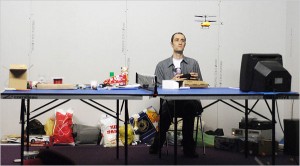L’Effet de Serge | Sydney Festival
- January 9th, 2012
- Posted in Uncategorized
- Write comment

There’s a room like any other. It has carpet. It has walls. It has glass doors. It has a ping-pong table.
There’s a man, like any other. He has limbs. And a voice. He has a head. He’s wearing an astronaut suit.
In a cloud of hissing smoke, to muffled music, the man enters the room and explains the what and why of the room, the actor, he lists the stuff on stage. He sits down because he chooses to. We know that because he tells us.
(There was a lone giggle from the audience.)
In a dry and even voice, the man, an actor playing the role, we suspect the role of Serge, introduces us to the world of Serge – which involves intimate in-house three-minute performances for his friends.
The clue to reading this whole piece is in the book Serge picks up at the beginning of the piece – a short piece by Beckett. And if you miss that, this might seem like a fairly pedestrian sequence of events. Also, if you are expecting a grand sweeping emotional arc and denouement from Serge, you might also feel a little disappointed. And confused.
L’Effet de Serge was written by Philippe Quesne for actor Gaetan Vourc’h. Quesne’s bio states that he created Vivarium studio in 2003 “in order to conceive and stage his own creations and to question theatre as an art of assemblage, a heterogeneous art. He brings together a group of actors visual artists, musicians and a dog.” He has created projects, installations and site-specific works that have traveled through France and the world – this particular piece has been performed in over twenty countries.
The Sydney Festival guide claims “With a nod to Jacques Tati, Samuel Beckett and Mr Bean, L’Effet de Serge is a haunting and humorous tribute to the pleasures and necessity of making art.”
Indeed. And it is.
There is a playful permission in the ideas of this show. That indulges the unusual, the unspoken and the simple. Serge himself is a simple man. There are small moments of joy, small moments of life – repetitious and fueled by crisps. There are small, domestic moments of pyrotechnics. There are small moments of social agony. There is a small moment of physical agony. There are small triumphs. There are small moments of delight. There are small moments of wild abandon. Small moments of awkward fragility.
And that is a pretty succinct portrait of the life of an artist.
What is particularly acute is the moment when just after Serge has made his artistic/performative offering to his guests (friends?) – they stare at him. Unable to articulate what to say. Unable to provide an articulate response. The event is summed up in a one work assessment, or a single line of weak but polite encouragement.
And this is so simple. We feel it precisely. We know it absolutely.
Serge expresses an idea, presents a moment, or offers a distraction or imaginative departure from the everyday world – and we sit dumbstruck like freshly picked zuchinnis offering basic, inarticulate responses.
The truth is that this show is more than it seems. It’s about how and what we notice. About the compulsion to invent and make art. About an inability to communicate about art. About the place of art in the world. It’s about having a sense of wonder, a sense of audience, a sense of curiosity, a sense of experimentation. About the everyday informing and inspiring the artist. About the social construct of theatre. About what is surprising and beautiful and strange. It’s also about opportunity – in love and in art – and missed opportunity – in love and art.
It’s about the artist’s invitation for us to see the world differently, or perhaps to see the world completely – full of things around us – ordinary things that in their compilation, in their framing, in their presentation, can be made sublime.